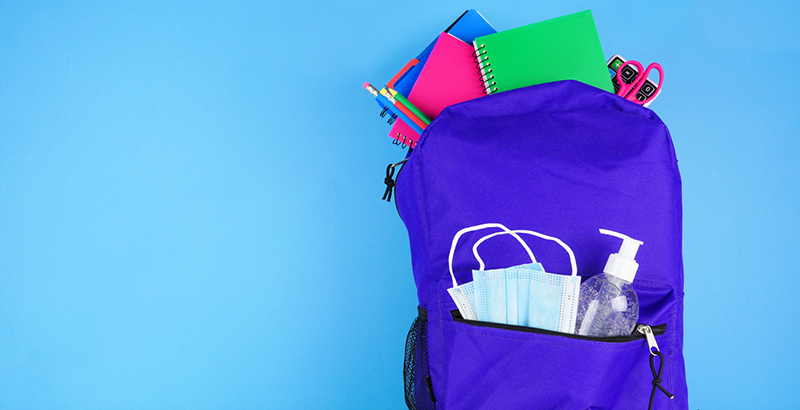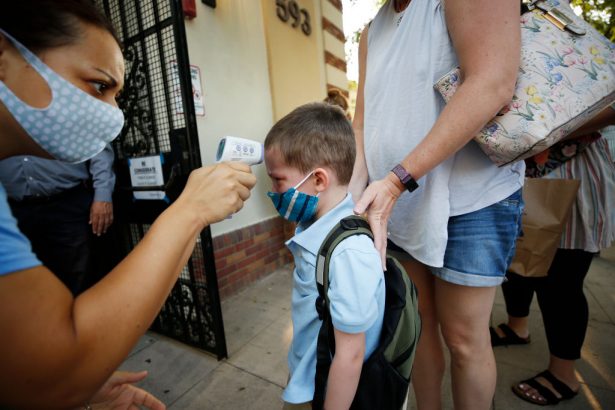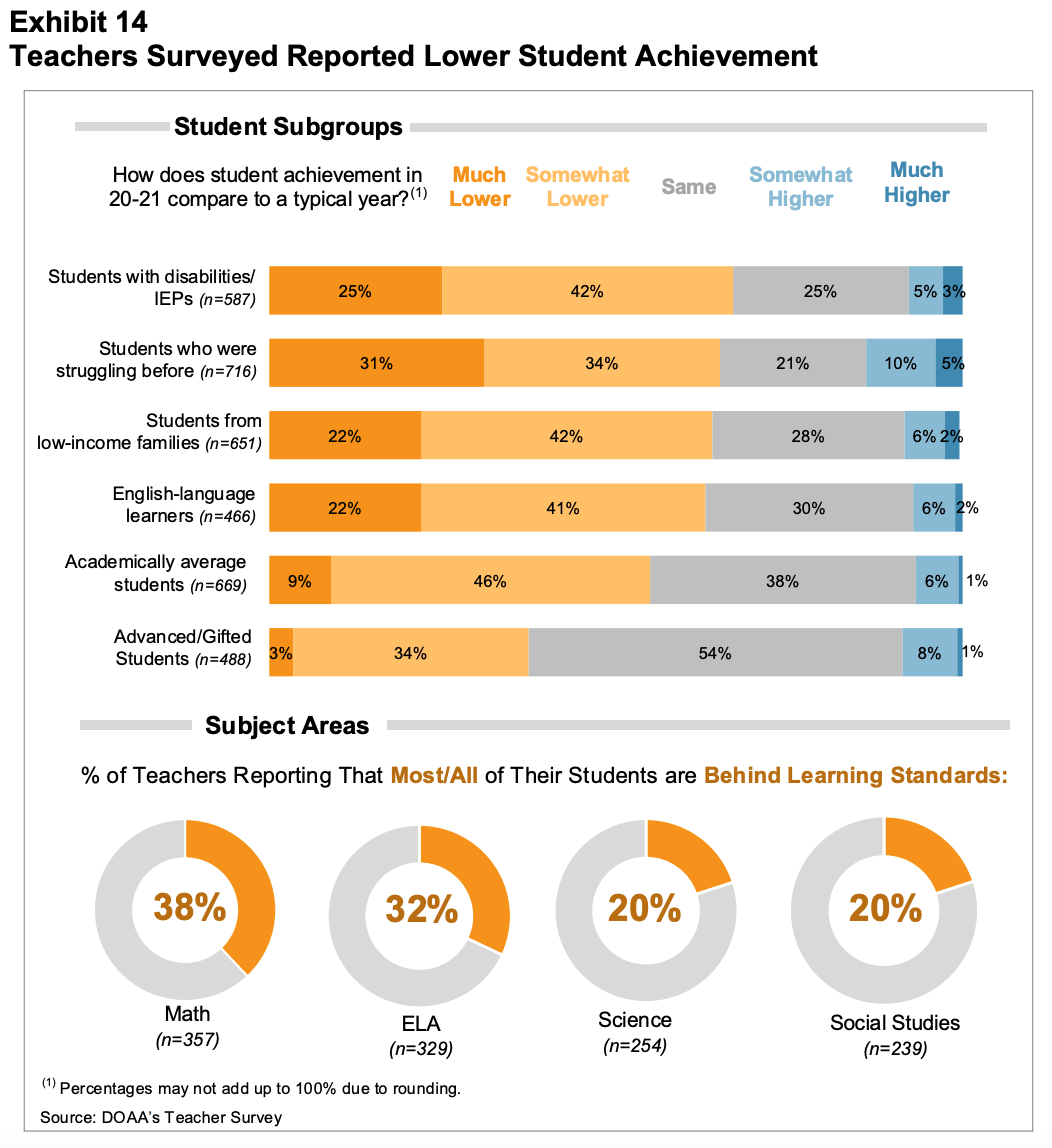The Week in COVID & Education Policy: Combating the Mental Health Crisis Among Youth, Parents Angry over School Closures and More

This is our weekly briefing on how the pandemic is shaping schools and education policy, vetted, as always, by AEI Visiting Fellow John Bailey. Click here to see the full archive. Get this weekly roundup, as well as rolling daily updates, delivered straight to your inbox — sign up for The 74 Newsletter.
The U.S. Surgeon General Warns of a Mental Health Crisis Among Young People: Report and New York Times story. Among the recommendations:
- Recognize that mental health is an essential part of overall health.
- Empower youth and their families to recognize, manage and learn from difficult emotions.
- Ensure that every child has access to high-quality, affordable and culturally competent mental health care.
- Support the mental health of children and youth in educational, community and child care settings.
- Address the economic and social barriers that contribute to poor mental health for young people, families and caregivers.
- Increase timely data collection and research to identify and respond to youth mental health needs more rapidly.

December 10, 2021 — The Big Three
Schools Are Closing Classrooms on Fridays. Parents Are Furious: Via The New York Times.
- “A few of these districts have closed with very little notice, sending parents to find child care, as well as summon the wherewithal to supervise remote learning. Beyond the logistics, many parents are worried that with additional lost days of in-person school, their children will fall further behind.”
- “But for many schools, the remote learning days — an option that did not exist before the pandemic — are a last-ditch effort to keep teachers from resigning. They are burned out, educators said, after a year of trying to help students through learning loss, and working overtime to make up for labor shortages.”
- “Battles in the classroom — from mask mandates to debates over critical race theory — have also taken a toll, said Randi Weingarten, the president of the American Federation of Teachers, the country’s second-biggest teachers’ union. ‘What you hear from teachers is that it’s been too much,’ she said. ‘And they’re trying the best that they can.’”
- “Last Friday, Theo Eggebrecht, 17, a senior in the arts track at Cass Technical High School in Detroit, did not have any at-home supplies for two of his arts classes that day. He said his science teacher did not show up for online class. Instead, Theo spent several hours doing chores, petting his cat and scrolling through TikTok. ‘I’m a senior, this is one of my last years of education,’ he said.”

Audit Shows Georgia Students Fell Months Behind: The most detailed report I’ve seen a state undertake: It covers learning loss, learning recovery and details on how funds are being spent on different activities (e.g. tutoring and mental health). Read the report here and local news coverage here.
- “By the end of the 2021 school year, students in majority-white schools were, on average, four months behind in math and three months behind in reading, according to the audit. Students in majority-Black schools were, on average, six months behind in math and reading,” WABE reported.
- “Although the percentage of virtual students decreased during the 2020-21 school year, most Asian-American students (58%) and almost half of Black students (49%) opted to remain virtual when schools offered an in-person option. Twenty-eight percent of Hispanic students and 15% of white students chose to remain online when given the choice to return.”
- “Of 112 school system survey respondents, 85 indicated that they reduced the number of instructional days by delaying the start of the school [year] (75 systems), extending the December holiday (19 systems) and/or eliminating school days throughout the year (16 systems). Only 24 of the 85 systems (28%) offset some missed time by extending the school year and/or adding other instructional days throughout the year. The remaining 61 systems did not make up days, impacting approximately 850,000 students.”
White House Releases Plan to Combat Delta and Omicron Variants: Fact sheet / Press briefing transcript / NBC story
- Two noteworthy items for schools:
- It seems like the Centers for Disease Control and Prevention is finally getting close to releasing guidance for test-to-stay programs.
- The administration will issue a new “Safe School Checklist” to give schools guidance for how to get as many of their staff and students vaccinated as possible.
- Plan components:
- Boosters for all adults
- Vaccinations to protect kids and keep schools open
- Expanding free at-home testing for Americans
- Stronger public health protocols for safe international travel
- Protections in workplaces to keep economy open
- Rapid response teams to help battle rising cases
- Supplying treatment pills to help prevent hospitalizations and death
- Continued commitment to global vaccination efforts
- Steps to ensure we are prepared for all scenarios
Omicron
Omicron Partly Evades Pfizer Vaccine’s Protection: Two reports out, both done with unbelievable speed.
- First a study (and press release) from South African researchers:
- “Laboratory experiments found that Omicron seems to dull the power of the Pfizer-BioNTech vaccine, but also hinted that people who have received a booster shot might be better protected,” the NYT reports.
- Second, a study from Pfizer:
- “‘It’s very clear that the Pfizer-BioNTech shot ‘should be a three-dose vaccine’ to deal with Omicron,’ BioNTech Chief Executive Officer Ugur Sahin said on a conference call. It may make sense to give boosters even sooner than now recommended, as early as three months after the first two doses.”
- “Still, two doses may prove effective in preventing severe illness from COVID-19, [Pfizer and BioNTech] said, because immune cells are able to recognize 80% of parts of the spike protein that the vaccine targets,” the WSJ reports.
- “‘These preliminary data appear to show the Pfizer vaccine does in fact protect against Omicron, and that’s very good news,’ said Philip Landrigan, director of Boston College’s Global Public Health and the Global Common Good program.”
- Go deeper: Muge Cevik breaks down the results, as does Stat. Katelyn Jetelina summarizes the South African study.
Early Reports Suggest Omicron May Be Less Dangerous
- “U.S. health officials said Sunday that while the Omicron variant of the coronavirus is rapidly spreading throughout the country, early indications suggest it may be less dangerous than Delta, which continues to drive a surge of hospitalizations,” the AP reports.
- Dr. Anthony Fauci: “Thus far, it does not look like there’s a great degree of severity to it. But we have really got to be careful before we make any determinations that it is less severe or it really doesn’t cause any severe illness, comparable to Delta.”
- More via Stat
Is Omicron Ominous?: Asks Eric Topol
- “The short answer is yes.”
- “The immune escape property of Omicron, with potential to override our vaccines, is the central concern and can be met 3 ways: (1) booster shots, (2) an Omicron-specific vaccine and (3) a pan-sarbecovirus vaccine which would theoretically be variant-proof.”
- “Early reports from South Africa indicated the possibility that cases were more mild, requiring less hospitalizations and oxygen supplementation. But the population assessed was predominantly young, had prior COVID or were vaccinated. We can hope this is the case but will not really know the answer to this question until much larger numbers of people aged 60-plus, those without prior infection or vaccination, or several months out from vaccination, are studied.”
- “Fortunately, there are no data to suggest Omicron is associated with more lethality or severe COVID than prior variants.”
Omicron is Spreading More Than Twice as Quickly as the Delta Variant in South Africa: Via the NYT and NBC
- “Doctors in South Africa say they have seen a dramatic rise in the number of children under 5 who need to be hospitalized with the COVID-19 Omicron variant.”
- “‘The incidents in those under 5 is now second-highest and second only to the incidents in those over 60,’ said Dr. Waasila Jassat with the South Africa Institute of Communicative Disease. ‘The trend that we’re seeing now that’s different to what we saw before is the particular increase in hospital admissions in children under 5 years.’”
Federal Updates
Food and Drug Administration: FDA authorizes Pfizer booster for 16- and 17-year-olds
U.S. Education Department: Launched two communities of practice to help states address the effects of the pandemic on students
Federal Communications Commission: The Senate voted 68-31 to confirm Jessica Rosenworcel as chair of the FCC. She’ll be the first female chair in the agency’s 86-year history.
- Gigi Sohn, President Joe Biden’s second nominee to the FCC, faces a steeper path to confirmation.
Broadband Provisions in the Infrastructure Investment and Jobs Act: I wrote an overview of the broadband provisions contained in the infrastructure package. Key parts of implementation will fall to states, that have to develop plans and prioritize projects. Some states are well positioned to leverage these funds, and others will need some additional capacity, creating an opportunity for philanthropic support.
Elementary and Secondary School Emergency Relief Fund Spending: Burbio has now tracked $40 billion of ESSER III allocations from over 1,600 districts that make up 39% of K-12 students.
Very Merry: The White House and Google teamed up to let you virtually walk through the Christmas decorations with Google Street View.
$350 Billion Coronavirus State and Local Fiscal Recovery Funds: A new dashboard created by Results for America and Mathematica — based on the spending plans of 150 local governments and tribal nations across the country — shows some early trends in how jurisdictions are investing or plan to invest their recovery funds:
- 75% are investing to address the negative economic impacts of COVID
- 72% are investing in public health
- 69% are investing to expand services to disproportionately impacted communities
- 61% are investing to replace lost revenues
- 56% are investing in housing
City & State News
California:
- Alberto Carvalho named next L.A. schools superintendent; observers warn of ‘political black hole’ that awaits
- California will start sequencing positive COVID tests taken at schools.
- Marin County parents could be criminally charged after knowingly sending a child with COVID-19 to school and sparking an outbreak.
- 34,000 L.A. Unified students have not complied with vaccine mandate, signaling problems ahead.
- “Shifting 34,000 students 12 and older into independent study would be challenging — especially as the district’s independent study program, called City of Angels, has been beset by staffing shortages and confusion after it was inundated at the start of the school year with about 10,000 students, a number that grew to 16,000.”
- “The 34,000 total by itself would make up one of the 25 largest school systems in California.”
New York: David Banks’s appointment to NYC schools chancellor welcomed in several circles
Illinois: How did COVID-19 affect attendance in southwest Illinois schools last year? The Belleville News-Democrat has a searchable database.
Kansas: Loose camel captured after fleeing nativity scene.
Kentucky: Louisville Courier Journal has profiles of school workers who passed away from COVID.
Louisiana: Only 3% of children 5-11 have received the COVID vaccine.
Pennsylvania: Delaware Valley School District canceled class Tuesday because 16 bus drivers tested positive for COVID-19, had symptoms or were exposed — and the district doesn’t have any drivers to cover the routes.
COVID-19 Research
Young People Recover Quickly From Rare Myocarditis Side Effect of COVID-19 Vaccine: New study. Of the 139 teens and young adults, ranging from 12 to 20 years of age, researchers identified and evaluated:
- Nearly every case (97.8%) followed an mRNA vaccine, and 91.4% occurred after the second vaccine dose.
- Onset of symptoms occurred at a median of two days following vaccine administration.
- Chest pain was the most common symptom (99,3%); fever and shortness of breath each occurred in 30.9% and 27.3% of patients, respectively.
- About 1 in 5 patients (18.7%) was admitted to intensive care, but there were no deaths. Most patients were hospitalized for two or three days.
- Nearly 18.7% had at least mildly decreased left ventricular function (squeeze of the heart) at presentation, but heart function had returned to normal in all who returned for followup.
We Opened the Schools and … It Was Fine: Aaron E. Carroll in The Atlantic.
- “The Delta surge began long before classes resumed, and looking at the state-by-state data, you’d be hard-pressed to find bumps that can be pinned on the beginning of the semester.”
- “Schools aren’t the problem. They never have been.”
- “One of the frustrating things about the pandemic has been our inability, even at this late date, to understand why surges occur. They hit communities with mask mandates, and communities without.”
- “What is pretty certain, however, is that schools are not to blame. … They haven’t done nearly as much damage as bars, restaurants and indoor events (including kids’ birthday parties), which never seem to receive the same amount of attention.”
FDA Authorizes AstraZeneca’s COVID-19 Antibody Drug: The drug helps to prevent COVID-19 infections in individuals who have weak immune systems or a history of severe side effects from coronavirus vaccines.
FDA Clears Use of Lilly’s COVID-19 Antibody Therapy for Kids: Via CNN. More via WSJ:
- “The authorization is the first for an antibody drug to treat young children, including newborns, who have tested positive for COVID-19 or been exposed to the virus and who are at high risk of developing severe cases including hospitalization or death.”
New Plant-based Vaccine: Medicago and GlaxoSmithKline announced “positive efficacy and safety results” from a global trial using what they say is the world’s first plant-based coronavirus vaccine.
The Benefits of Vaccinating Kids against COVID Far Outweigh the Risks of Myocarditis: Via Scientific American
Revisiting COVID-19 Policies: 10 evidence-based recommendations for where to go from here: via BMC
Viewpoints
Should I Get a Booster?: Great piece by Emily Oster.
Messaging: I want to specifically call out the last section of Emily’s newsletter because this is so important, particularly at this moment when pandemic guidance news fatigue is so high.
- “It’s not that the message currently being sent is wrong. The advice that we are getting — on boosters or anything else — is usually based on the best knowledge at the moment. The problem is that it’s too often delivered with an air of certainty that the knowledge doesn’t support.”
- “This would be fine if people were amnesiac robots. If everyone woke up in the morning, forgot everything from the day before, checked the current guidance and seamlessly took up that guidance, then the strategy of changing the guidance every day would be great. It would let you incorporate even small changes in knowledge in a seamless way.”
- “But people are not amnesiac robots, and our trust in guidance is based on consistency and understanding. In this world, we need messaging with more nuance, messaging that does a better job of explaining why the guidance is what it is and why it might change.”
An Idea for This Moment: Districts Can Pay Families to Help Get Students and Schools Back on Track: Via Marguerite Roza
More Students Flunk This High School Course Than Any Other: Blog post by Bill Gates.
Anticipating the Top 2022 Risks in Politics & Policy: Bruce Mehlman is out with his latest deck.
Parent Opinions: New poll from Morning Consult and EdChoice
- Although Black parents’ comfort with their children returning to school has increased over the past couple of months, they remain less comfortable than white parents.
- Both Black and white parents experienced a decrease in willingness to vaccinate their children. Hispanic parents are currently the most willing to vaccinate their children.
- School parents — regardless of race or ethnicity — generally are positive about how local school boards are handling matters in K-12 right now. Black and Hispanic parents are much more likely to give the Biden administration high marks when compared with white parents. Hispanic parents are the most likely to give good grades to their state’s governor and legislature.
- Among Black parents, interest in learning pods has held steady this month, with about one-third still indicating they have some level of consideration.
- Black parents continue to express very high levels of support for education savings accounts, school vouchers and public charter schools.
Schools Need Support to Reinvent Themselves. Will Philanthropy Step Up to Help?: Via New Schools Venture Fund
Schools are Back in Person, but Quarantines, Health Concerns Have Students Missing More Class: Via Chalkbeat
Resources: Via Education Resource Strategies
- Moving from Plan to Action: An Analysis of Districts’ ESSER Plans
- Five Actions State Education Leaders Can Take to Inspire Transformative ESSER Spending
- District Budget Development Process: Six Key Changes for FY23
…And on a Lighter Note
Just the Best: “I love you” face off between brothers.
The most adorable ‘I love you’ face off between brothers. ❤️ pic.twitter.com/UWRu7SM514
— Karine Jean-Pierre (@K_JeanPierre) December 3, 2021
ICYMI @The74
Weekend Reads: In case you missed them, our top five stories of the week:
- Supreme Court: ‘Equal Treatment, not Special Treatment’: Conservative Supreme Court Justices Appear Ready to Strike Down Religious Barriers to Public School Choice Funding
- Pandemic Recovery: ‘Try Everything to Find Them’: Districts Launch New Efforts to Get Chronically Absent 9th Graders Back in Class
- School Safety: ALICE, America’s Most Controversial Active-Shooter Training that Teaches Kids to Fight Back, Saved Dozens of Lives in Oxford HS Attack, CEO Claims
- Critical Race Theory: Republican Bill that Limits How Race, Slavery and History Are Taught in Texas Schools Becomes Law
- Case Study: A Massachusetts Town Boosts Students’ STEM Learning by Letting the Students Do the Talking, ‘It’s Real Life’
For even more COVID policy and education news, subscribe to John Bailey’s daily briefing via Substack.
Disclosure: John Bailey is an adviser to the Walton Family Foundation, which provides financial support to The 74.
Get stories like these delivered straight to your inbox. Sign up for The 74 Newsletter

;)
